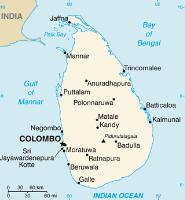COLOMBO, Sri Lanka -- The New Year in Sri Lanka began with an all-out confrontation between government forces and the Liberation Tigers of Tamil Eelam (LTTE), a terrorist group that has been battling the Sri Lankan government on and off for decades. An already fragile ceasefire accord between the two warring parties was irreparably damaged on Jan. 3 when the government of President Mahinda Rajapaksa withdrew from the agreement. This in turn rendered the presence of the Sri Lanka Monitoring Mission, an independent body of international investigators observing and recording human rights violations on the island, obsolete. The fact that it was the government, not the Tamil Tigers, that officially abandoned the pursuit of a diplomatic solution to the war raises suspicion that the government wants no limits on the full-scale war that it is embarking on in northern Sri Lanka. Hostilities by both the LTTE and Sri Lanka's armed forces had persisted during the ceasefire -- primarily clandestine intermittent operations carried out in the obscurity of inland jungles. It is not surprising that terrorists committed such violations. But it was disappointing when the Sri Lankan government began using some of the same tactics as the LTTE. The abrogation of the ceasefire agreement confirmed many observers' misgivings about the current regime. The government, under the leadership of President Mahinda Rajapaksa, has pursued a hard line toward terrorism from the outset. It has placed a very high premium on a very narrow definition of security -- unlike its predecessors, the current regime never attempted to work with the LTTE towards a peaceful solution. In the process, Sri Lankan civilians have suffered the most. This is particularly the case in eastern Sri Lanka, where human rights abuses such as extrajudicial killings, forced disappearances and abductions of dissenters and children have been part and parcel of the government campaign to win back control of the multi-ethnic eastern provinces from the LTTE. Today, Batticaloa, a town on the island's eastern shore, while under the complete control of the Sri Lankan Army, has the look and feel of a war zone. Long stretches of coiled barbed wire shackle the coastal city and roadblocks are manned by heavily armed forces.
With Sri Lankan Government’s Tactics, Escalation of Tamil Conflict Looks Inevitable

